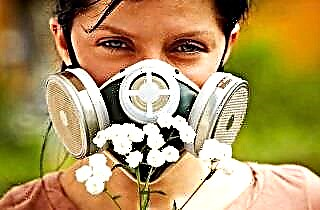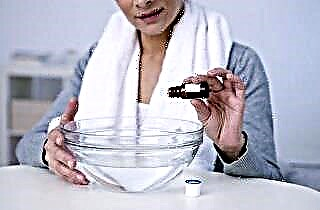The situation when thick white snot is not blown out is very unpleasant and familiar to almost everyone. This is a constantly stuffy nose, shortness of breath, headache and many other related troubles. If left untreated, such a runny nose can cause the development of serious diseases of the upper respiratory tract.
Causes and Symptoms
 Consider the reasons why a thick runny nose may appear in an adult who is quite healthy at first glance, and on which the treatment should be determined:
Consider the reasons why a thick runny nose may appear in an adult who is quite healthy at first glance, and on which the treatment should be determined:
- Indoor air is too dry. If you stay in such conditions for a long enough time, then the mucous membranes begin to dry out. By trying to protect them, the body produces more mucus. It can accumulate in the nasal passage and make breathing difficult. Especially often, such a runny nose makes itself felt at night. It is useless to treat white snot - this is a protective reaction of the body. The easiest way to get rid of this problem is to simply ventilate the room and humidify the air.
- Allergic reaction. The constant presence of an allergen (old tobacco smoke, household chemicals, indoor flowers and plants, pets, etc.) provokes the same constant response of the body. By secreting thick white mucus, it tries to prevent the penetration of the allergen inside. An adult working in hazardous work can have the same reaction. It is impossible to cure an allergic rhinitis until contact with the allergen is interrupted. You can only temporarily alleviate the condition with the help of medication.
- Colds. If at the first stage of a cold, the snot is liquid and transparent, then over time they thicken, become white and viscous, and if untreated, they can accumulate in the nose, acquiring a yellowish tint. For an adult with a strong immune system, such a runny nose is not dangerous and treatment is not required.
 Anatomical features. With severe curvature of the nasal septum (congenital or acquired) or very narrow nasal passages, the snot stagnates in the nose, gradually thickening. You can get them out of there only with some effort. But it makes no sense to treat it with medications, you can only eliminate the problem by surgery.
Anatomical features. With severe curvature of the nasal septum (congenital or acquired) or very narrow nasal passages, the snot stagnates in the nose, gradually thickening. You can get them out of there only with some effort. But it makes no sense to treat it with medications, you can only eliminate the problem by surgery.- Pathogenic microorganisms. When pathogenic microflora enters the nose, the immune system is triggered. A thick, viscous coryza appears. At first, the snot is white, if the disease is not treated, then they change color to yellow or green, depending on the viruses or bacteria present.
Without a doubt, the effectiveness of treatment directly depends on how accurately the reason for the appearance of a thick rhinitis is determined.
Traditional methods
To get rid of a thick runny nose, first of all, you need to make the snot more liquid - so they can come out faster. The usual washing will help in this, for which a solution of sea salt (a teaspoon in a glass of clean water), a decoction of chamomile or calendula, furacilin, a weak solution of potassium permanganate are suitable. Remember that flushing is not a treatment, but only a necessary preparatory step.
 In the event that the snot does not blow out, it will most likely not work to draw them in on your own. Therefore, you will have to use a small syringe for washing.
In the event that the snot does not blow out, it will most likely not work to draw them in on your own. Therefore, you will have to use a small syringe for washing.
It is necessary to flush the nostrils one by one, and the pressure of the water should not be too strong so that the snot from the nose does not fall into the Eustachian tube. When some of the mucus is washed out, you can try to gently blow your nose out of the rest.
Blowing out too viscous snot, especially when the nose is very stuffy, is very dangerous. The nasal passage connects to the middle ear through a narrow ear canal. And in the middle ear is the eardrum. Blowing abruptly will create a difference in air pressure on both sides of the eardrum, and blowing abruptly may even rupture the eardrum. Therefore, if necessary, rinse the nose several times until the snot comes out relatively easily.
Then you can try to get rid of a thick runny nose using folk methods:
- Kalanchoe juice - perfectly cleans the nose, as it causes slight irritation of the mucous membranes, provoking reflex sneezing. You need to use only freshly squeezed juice, you can mix it with honey. Apply only after rinsing!
 Beetroot juice - has excellent anti-inflammatory properties, helps to quickly get rid of nasal congestion. You can add a little honey to the juice and instill 3-5 drops in each nostril up to 5 times a day.
Beetroot juice - has excellent anti-inflammatory properties, helps to quickly get rid of nasal congestion. You can add a little honey to the juice and instill 3-5 drops in each nostril up to 5 times a day.- Potato steam - quickly removes puffiness and is able to make nasal discharge less thick. To do this, it is enough to boil a few potatoes, knead them well and breathe in the steam over a saucepan, covering your head with a towel.
- Inhalation with herbal decoctions or essential oils (any coniferous, mint, eucalyptus, juniper, sage, etc.). If you don't have an inhaler at hand, then you can add a few drops of oil (up to 10) to a liter of boiling water and breathe in the same way as over potatoes or use an aroma lamp, which at the same time cleans up the air in the room.
- Rubbing with camphor oil is best used at night. Dilute camphor oil with baby cream or regular sunflower in a ratio of about 1: 2 and rub the breast. You can apply a little of the mixture to the bridge of your nose (be careful not to get it in your eyes!). Ready-made warming balms with natural oils are also good. It is better to do it before bed, so that later the body does not cool down.
If traditional methods do not help, and a thick white runny nose does not go away within a few days, you will have to start treating them with traditional medicine.
With the help of a doctor
Antihistamines are usually the fastest way to relieve nasal congestion, even if the runny nose is not allergic. They relieve swelling in just a few minutes, and the nose begins to breathe more freely. But this is only instant help. The solution to the problem itself lies in complex treatment, especially if a viral infection is present in the body, which is signaled by a changed color of snot.
 If it is white or slightly yellowish, then antibiotic drops are not needed. The vasoconstrictor drugs "Naftizin", "Galazolin" and others will help to reduce the amount of secretions. It is impossible to use them for a long time, and there is no need, since, most likely, the disease is already at the stage of recovery.
If it is white or slightly yellowish, then antibiotic drops are not needed. The vasoconstrictor drugs "Naftizin", "Galazolin" and others will help to reduce the amount of secretions. It is impossible to use them for a long time, and there is no need, since, most likely, the disease is already at the stage of recovery.
If the discharge is yellow or orange, it is best to see a doctor. Apparently, this is already the initial stage of sinusitis, which must be treated immediately and correctly. Nasal drops with antibacterial components are indispensable, and it is better if a doctor prescribes them. Effective new generation drugs are: "Isofra", "Sofradex", "Polydex", "Bioparox". There are other excellent remedies, but each of them has its own characteristics of use, so a doctor should prescribe them.
The yellow-green color of the snot indicates that the discharge is of a bacterial nature, and the immune system is trying to cope with it on its own. But if they thicken and do not go away in a few days, then the immunity of an adult is too weak and it is worth strengthening it with the help of immunomodulators: Amizon, Interferon, etc. It is better to combine them with nasal drops with an antibiotic.
Drops based on natural vegetable oils "Pinosol", which can be bought at any pharmacy, have a good effect.In order to alleviate the condition, 3-5 drops are enough in each nostril three times a day, and the course of treatment can be up to 14 days, since the drug is not addictive.
 It is better not to prescribe medications on your own. Only a doctor will be able to choose the right combination of them, which will give the maximum effect just for you. In addition, some of them have medical indications for use. Women need to be especially attentive to traditional medicines during pregnancy - the wrong choice can lead to abnormal development of the fetus or placental abruption.
It is better not to prescribe medications on your own. Only a doctor will be able to choose the right combination of them, which will give the maximum effect just for you. In addition, some of them have medical indications for use. Women need to be especially attentive to traditional medicines during pregnancy - the wrong choice can lead to abnormal development of the fetus or placental abruption.
It is imperative to consult a doctor even if, after home treatment, the nasal congestion has not gone away, the snot has changed its color, they have an unpleasant odor, a strong cough has begun, the body temperature has risen, or severe persistent head (ear) pains have arisen. In that case, the continuation of self-medication can lead to very serious complications - sinusitis, bronchitis, otitis media.

 Anatomical features. With severe curvature of the nasal septum (congenital or acquired) or very narrow nasal passages, the snot stagnates in the nose, gradually thickening. You can get them out of there only with some effort. But it makes no sense to treat it with medications, you can only eliminate the problem by surgery.
Anatomical features. With severe curvature of the nasal septum (congenital or acquired) or very narrow nasal passages, the snot stagnates in the nose, gradually thickening. You can get them out of there only with some effort. But it makes no sense to treat it with medications, you can only eliminate the problem by surgery. Beetroot juice - has excellent anti-inflammatory properties, helps to quickly get rid of nasal congestion. You can add a little honey to the juice and instill 3-5 drops in each nostril up to 5 times a day.
Beetroot juice - has excellent anti-inflammatory properties, helps to quickly get rid of nasal congestion. You can add a little honey to the juice and instill 3-5 drops in each nostril up to 5 times a day.

